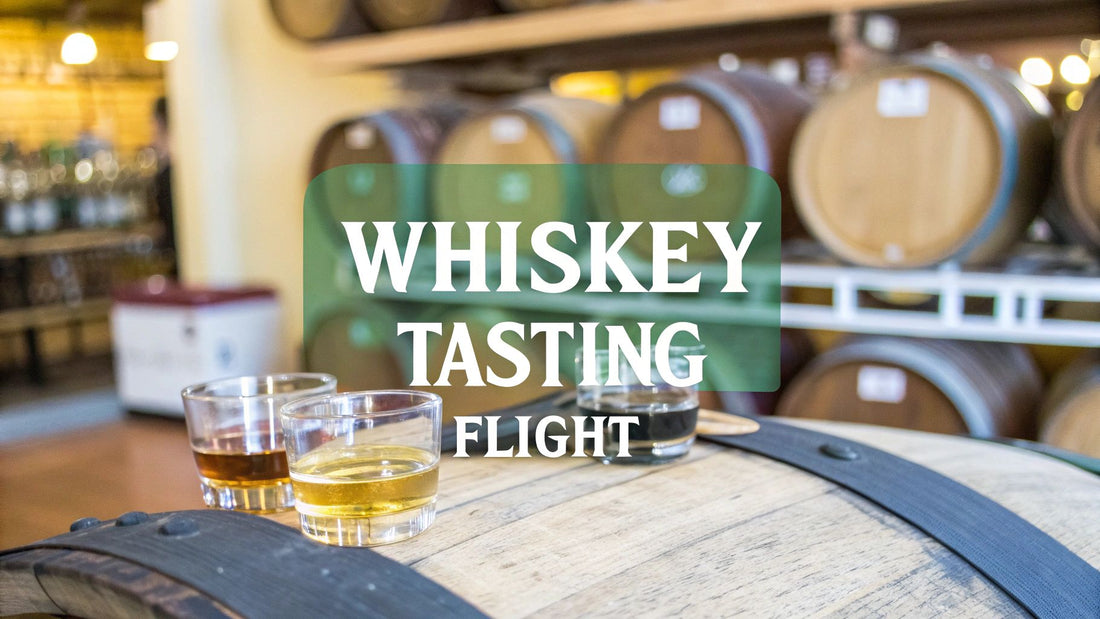Ever walked into a bar, stared at a wall of whiskey, and just felt… overwhelmed? You’re not alone. That’s where a whiskey tasting flight comes in.
It’s a simple but brilliant concept: a curated lineup of small whiskey pours, usually 3 to 5 different spirits, served together so you can compare them side-by-side. Forget committing to a full, pricey bottle of something you might not even like. A flight is your ticket to explore, especially for newcomers looking to discover what they truly enjoy without any pressure.
Your Guide to the Whiskey Tasting Flight
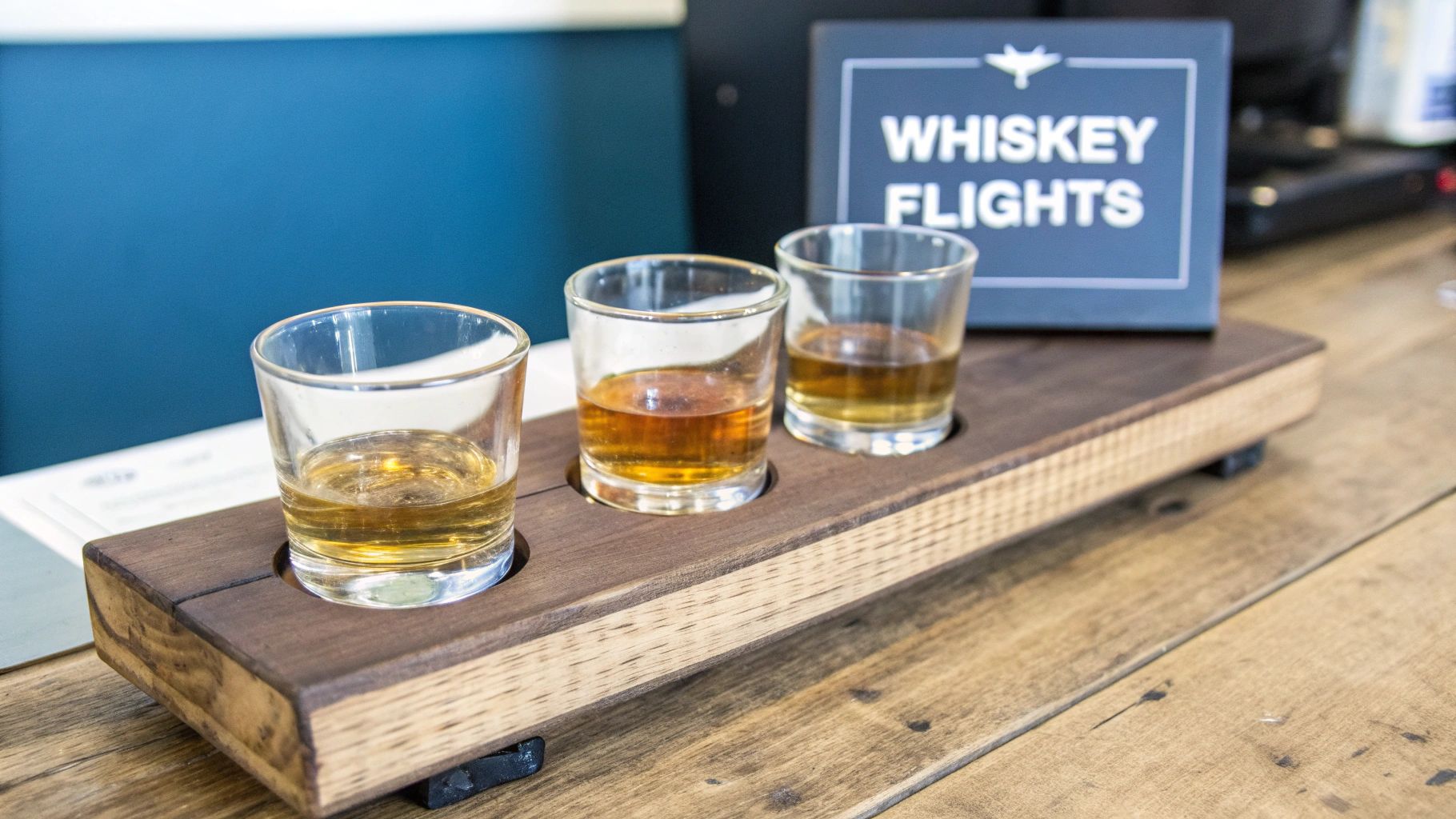
Think of it like a "sampler platter" for spirits. Instead of just ordering a single glass of something you think you'll enjoy, a flight is a guided tour. It’s an approachable, educational experience that strips away the intimidation that can sometimes hang around the world of whiskey.
For anyone new to whiskey, this format is a game-changer. It’s a low-pressure way to figure out what you genuinely enjoy. You can pit a smooth, wheated bourbon against a spicy rye, or see for yourself how different barrel finishes completely change the final flavor—all in one sitting.
Discovering Your Palate
At its heart, a whiskey flight is all about discovery. By tasting small amounts of different whiskeys, you start building a personal "flavor library" in your head, pinpointing the specific aromas and tastes that really speak to you.
A well-designed flight helps you:
- Understand Variety: You get to explore the whole spectrum, from sweet and mellow bourbons to the smoky, peaty Scotches that can smell like a campfire.
- Compare and Contrast: Tasting them one after another is when the magic happens. The subtle (and sometimes not-so-subtle) differences between each pour really pop.
- Learn Without Commitment: It’s the most cost-effective way to try premium or rare whiskeys before you decide to splurge on a whole bottle.
This approach gets really exciting when it shines a spotlight on American craft whiskey brands. Flights are the perfect stage for smaller, independent distilleries to show off their innovative spirits, giving you a taste of unique grains, creative aging techniques, and regional styles you just won't find on every back bar.
To give you an idea of what you might encounter, tasting flights are often built around a specific theme.
Common Whiskey Flight Themes at a Glance
| Flight Type | What You'll Explore | Who It's Best For |
|---|---|---|
| Regional Tour | Whiskeys from a specific place, like Kentucky Bourbon, Islay Scotch, or Japanese Single Malts. | Drinkers who want to understand how "terroir" or local style influences flavor. |
| Vertical Tasting | The same whiskey at different ages (e.g., a 12, 15, and 18-year-old). | Anyone curious about how time in the barrel transforms a spirit. |
| Horizontal Tasting | Different whiskeys of the same age or style but from various distilleries. | Those who want to compare how different producers interpret a classic style. |
| Mash Bill Comparison | Bourbons with different grain recipes (e.g., standard rye, high-rye, wheated). | Bourbon lovers looking to taste the impact of corn, rye, and wheat. |
| Barrel Finish Focus | The same base whiskey finished in different types of casks (e.g., sherry, port, rum). | Drinkers interested in the powerful influence of the barrel on the final flavor. |
These themes turn a simple tasting into a focused exploration, helping you connect the dots between how a whiskey is made and how it tastes.
More Than Just a Drink
Ultimately, a whiskey flight transforms sipping a spirit into a social and educational activity. It’s a fantastic way to connect with friends, pick the brain of a knowledgeable bartender, or simply take a quiet moment to appreciate the incredible craftsmanship in your glass. It's no surprise this experience has become a cornerstone of the modern whiskey boom.
In fact, the global whiskey market is projected to grow from USD 118.5 billion in 2025 to an astounding USD 345.7 billion by 2035. This incredible surge is fueled by tasting rooms and bars using flights to introduce people to higher-quality, unique whiskeys. You can learn more about the trends shaping the whiskey market right here.
This format empowers you to move beyond the familiar labels on the shelf and confidently explore the vast, flavorful world of whiskey, one small pour at a time.
How to Properly Taste Your Whiskey
Unlocking the story inside a glass of whiskey isn't about having some "perfect palate." It's more about following a simple, mindful process. A whiskey tasting flight just happens to be the ideal setting to practice and hone this very skill.
By following four key steps—See, Swirl, Smell, and Sip—you can turn a simple drink into a full-blown sensory experience. It's how you build confidence with every single pour. This whole process is designed to be personal and, most importantly, fun. The goal isn't to find the "right" answers but to discover what you enjoy.
For a deeper dive into the nuances of this method, our complete guide on how to taste whiskey offers even more detailed tips to refine your approach.
See The Story in the Glass
Before you even think about taking a sip, just hold your glass up to the light. The very first step in a whiskey flight is simply to observe. What color do you see? Is it a pale straw, rich gold, a deep amber, or maybe even dark mahogany?
A whiskey's color offers clues about its journey. Generally, the darker the whiskey, the longer it has spent aging in a wooden barrel. For American craft whiskeys, the law requires them to be aged in new, charred oak containers, which imparts a ton of color and flavor relatively quickly. A deep, reddish hue might hint at a bourbon aged for many years, while a lighter, golden color could suggest a younger spirit.
Swirl to Awaken the Aromas
Next, give the glass a gentle swirl. Watch how the whiskey coats the inside of the glass and then slowly runs back down. These streaks are called "legs" or "tears," and they can tell you a bit about the whiskey's alcohol content and texture. Thicker, slower-moving legs often mean a higher proof or a more viscous, oilier spirit.
But the main reason we swirl is to aerate the whiskey. This simple action increases the liquid's surface area, allowing more of its aromatic compounds to evaporate and rise from the glass, getting your senses ready for the next crucial step.
The following infographic breaks down the core actions for conducting a simple and effective tasting at home.
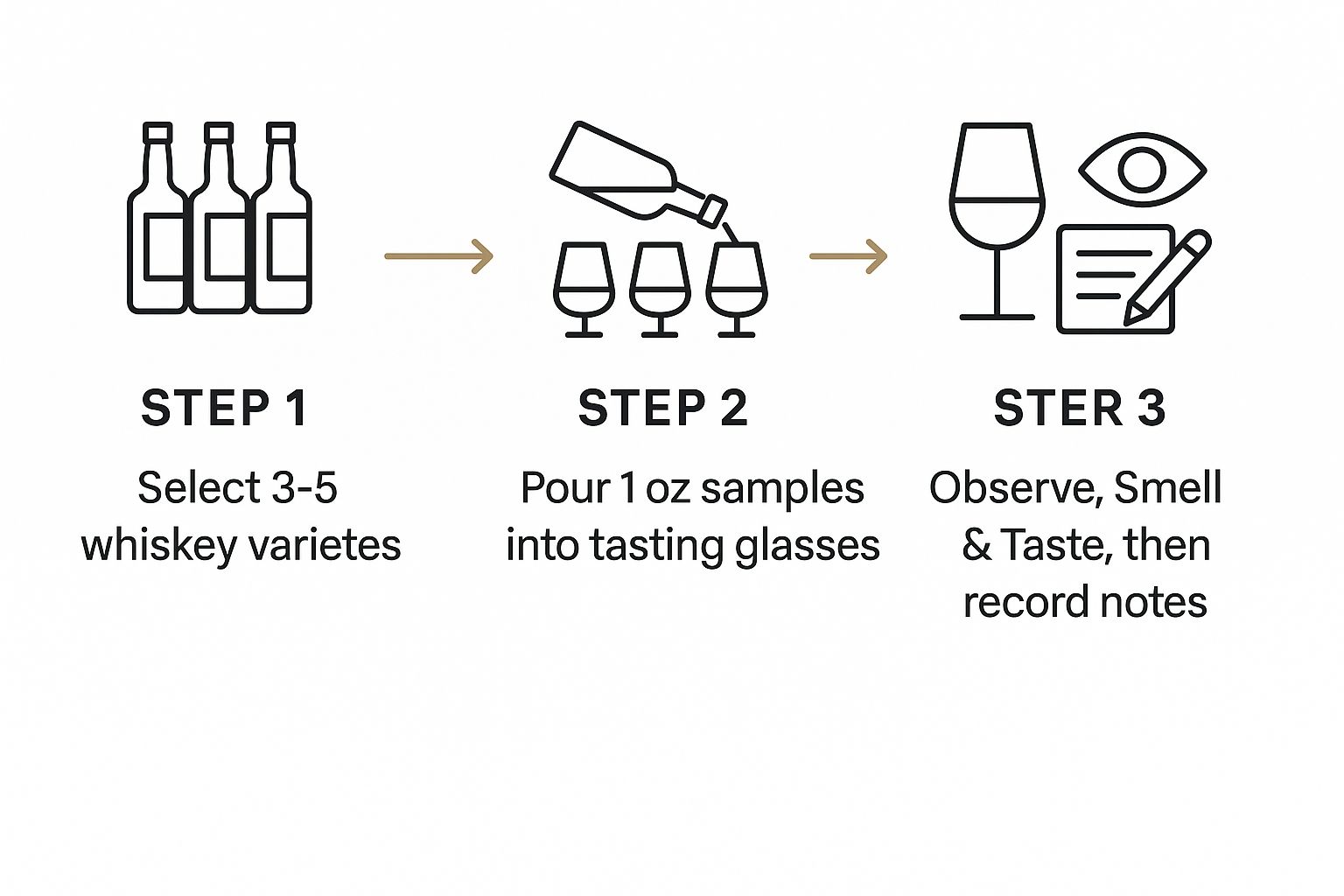
This visual guide simplifies the experience into three easy stages, proving you don't need to be an expert to host a successful whiskey tasting flight.
Smell The Nuances
Now, bring the glass up toward your nose. This step, known as nosing, is arguably the most important part of tasting. Your sense of smell is responsible for the vast majority of what you actually perceive as flavor.
Pro Tip for New Drinkers: Don't just stick your nose deep into the glass and take a huge whiff. The alcohol vapors will overwhelm your senses. Instead, hold the glass a few inches from your face, keep your mouth slightly open, and gently waft the aromas toward you.
Try to identify what you're smelling. Remember, there are no wrong answers here—it’s all about personal association.
- Sweet Notes: Can you pick up scents like vanilla, caramel, honey, or brown sugar?
- Fruity Notes: Do you detect hints of apple, cherry, citrus, or maybe dried fruits like raisins?
- Spicy Notes: Are there aromas of cinnamon, clove, black pepper, or oak coming through?
- Earthy Notes: Do you notice anything like leather, tobacco, or even smoke?
Move the glass back and forth, smelling with one nostril and then the other. Taking your time here will dramatically enrich that final, glorious step.
Sip and Savor The Finish
Finally, it's time to taste. Take a small sip—just enough to coat your tongue. Resist the temptation to swallow it right away. Instead, let the whiskey rest on your palate for a moment.
A popular technique among enthusiasts is the "Kentucky Chew." This just means gently "chewing" the whiskey, moving it around your mouth to make sure it hits every taste bud. This helps you experience the full range of flavors from the initial taste (the attack), to the mid-palate, and finally, the finish.
As you swallow, breathe out through your nose. This is where the finish—that lingering taste and sensation—reveals itself. Is it short and clean, or does it hang around with warmth and complex flavors? Pay attention to how the taste evolves. This complete journey, from the first look to the lasting finish, is the true essence of enjoying a whiskey tasting flight.
Creative Whiskey Tasting Flight Themes to Explore
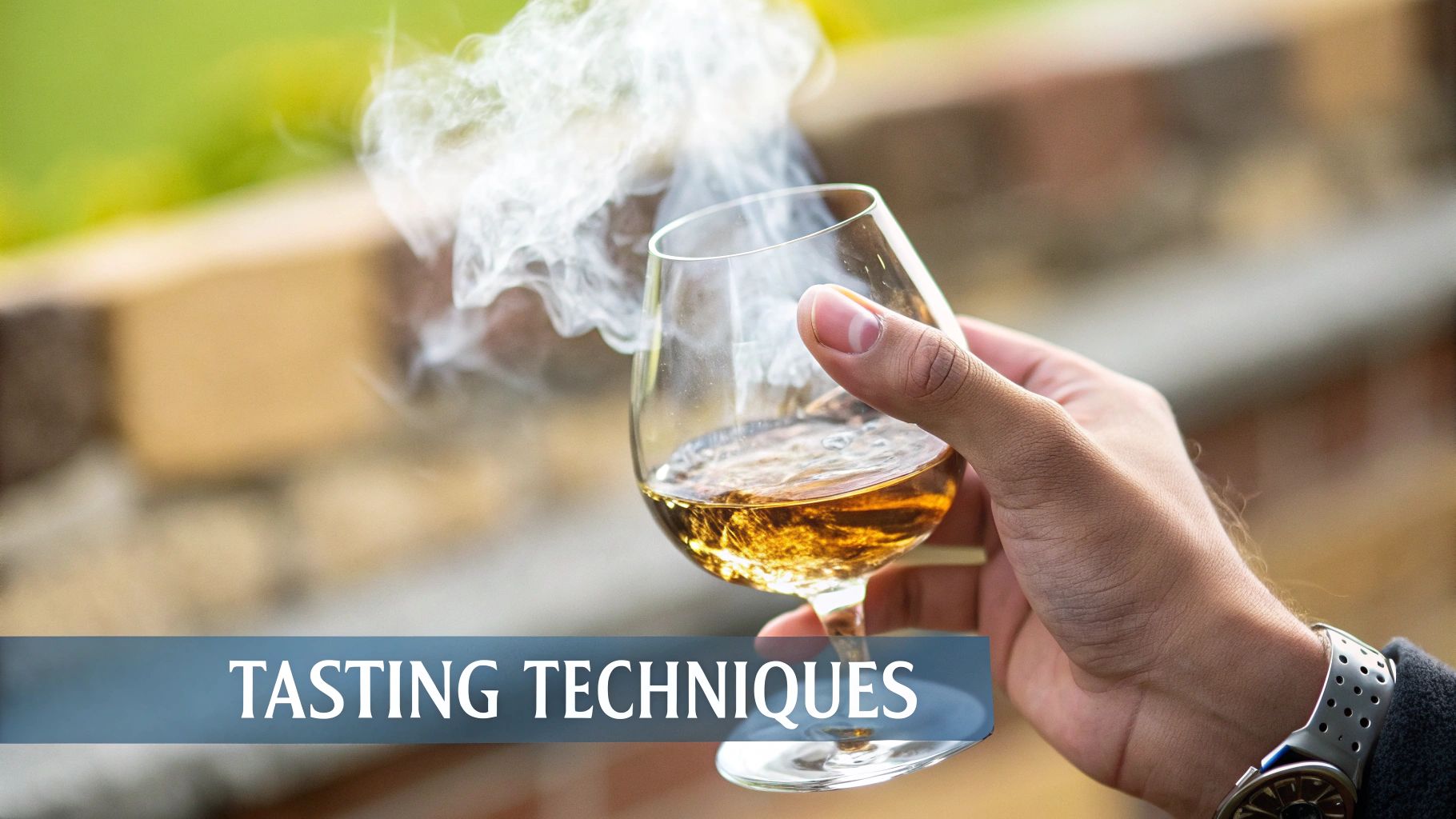
Putting together a whiskey tasting flight is a bit like being a DJ for your palate. You’re not just pouring drinks; you’re setting a mood and telling a story with every bottle you choose. A good theme elevates a simple tasting into a full-blown adventure, giving you a clear path to understanding what makes each whiskey tick.
For anyone new to the whiskey world, a theme is your best friend. It cuts through the noise and makes the whole experience more fun and educational. It’s all about providing context and helping you connect the dots between how a whiskey is made and how it tastes. Let’s dive into a few creative themes you can try at home or keep an eye out for at your local bar.
A Tour of American Craft Whiskey
This theme is a phenomenal way to explore the incredible boom of small, independent distilleries popping up all over the country. The mission here is to taste the influence of "terroir"—how a specific region's climate, culture, and local ingredients shape the spirit in the bottle. Think of it as a road trip in a glass.
For this flight, you’ll want to grab three or four whiskeys from distinctly different states. This is the best way to really appreciate the wild diversity of the American whiskey scene.
- From Texas: Find a bourbon from a distillery like Garrison Brothers. The scorching Texas heat makes the whiskey age faster, often leading to huge, oak-forward flavors.
- From Colorado: Look for a single malt from a producer like Stranahan's. The high altitude and Rocky Mountain water create a unique character that's often fruity and malty.
- From New York: Grab a rye whiskey from a place like Hudson Whiskey. New York has a long, storied history with rye, and today’s distillers are crafting expressions that are beautifully spicy and complex.
An approach like this doesn't just support innovative American craft brands; it shatters any preconceived notions about what American whiskey can be. It’s a genuine celebration of local craftsmanship.
Bourbon Versus Rye Showdown
There’s a reason this is a classic theme—it’s hands-down one of the best ways for a beginner to grasp the direct impact of a whiskey’s main grain. Bourbon and rye are both quintessential American whiskeys, but their base ingredients send their flavor profiles in completely different directions. It’s the perfect lesson in how one simple recipe tweak creates a whole new world of taste.
By law, bourbon must be made from at least 51% corn, which is where it gets its signature sweetness—think notes of caramel, vanilla, and cherry. Rye whiskey, on the other hand, must contain at least 51% rye grain, which delivers a spicier, more peppery, and often drier experience.
To set this one up, grab a classic bourbon and a classic rye. If you can get them from the same distillery, even better—that helps isolate the main variable. For instance, pitting Bulleit Bourbon against Bulleit Rye is a great move. That head-to-head comparison makes the core differences in sweetness and spice jump right out at you.
The Finish Line: A Flight of Cask Finishes
Ready to level up? A "finish line" flight zones in on whiskeys that have done a second tour of duty in a different barrel. For this, distillers take a fully mature whiskey and move it into a cask that once held something else—like sherry, port, or rum—to add incredible new layers of flavor.
This theme really puts the spotlight on the magic of the barrel. You can literally taste how the same base spirit can be twisted and transformed into something completely new. For a masterclass in this technique, check out American craft distilleries that have perfected the art, like Angel's Envy (port barrel finish) or Hillrock Estate Distillery (sherry cask finish).
This type of experimentation has become a huge driver of growth in the whiskey world, especially for bourbon. As drinkers hunt for more unique flavors, distilleries are getting more and more creative with their finishes. Sales of high-end bourbon have skyrocketed, with the more than 2,500 craft distilleries in the U.S. using tasting flights to show off these innovative barrel-finished spirits. Dig into more insights on the current bourbon industry outlook. This hands-on approach is what fuels premium sales and helps us all discover our next favorite bottle.
How to Host a Whiskey Tasting at Home
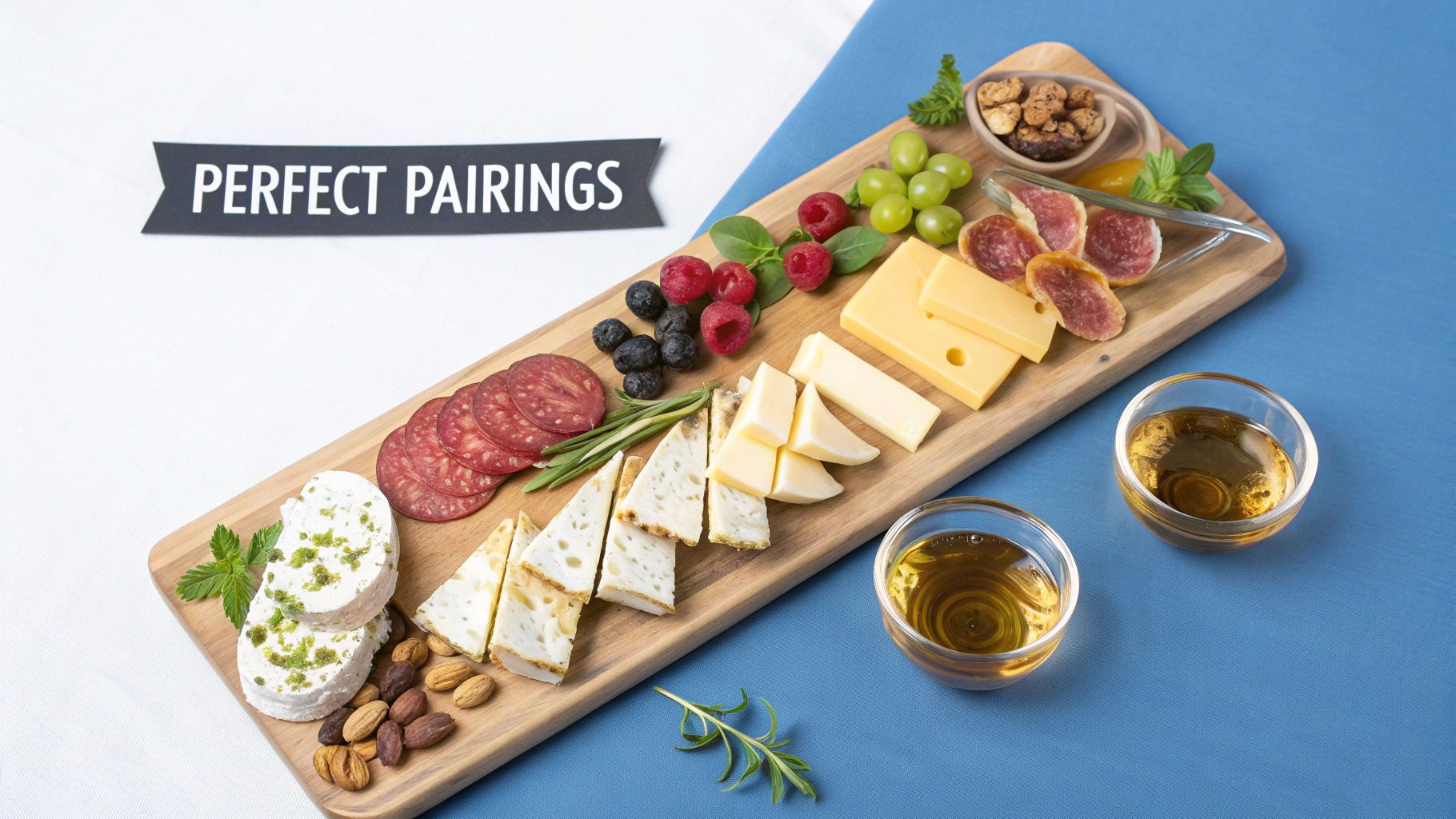
There comes a point in every whiskey lover's journey where you want to share what you've discovered. Hosting a whiskey tasting flight at home is one of the best ways to do it, and it doesn't need to be some stiff, formal affair. The whole point is to have fun and create a relaxed, memorable night for your friends, whether they're whiskey nerds or just curious.
A little bit of planning goes a long way. With the right setup and a loose game plan, you can easily guide everyone through a tasting that’s both enlightening and genuinely enjoyable. This isn’t about getting every tasting note "correct"—it’s about exploration and good conversation.
Setting the Stage for Success
Before your friends show up, you’ll want to get a few things in order. You don’t need a professional tasting room; you can create a fantastic experience with stuff you probably already have around the house.
The most important piece of the puzzle is the glassware. Sure, a proper tulip-shaped Glencairn glass is designed to funnel aromas right to your nose, making it easier to pick up on the subtleties. But don’t let a lack of specific glasses stop you. A small wine glass or even a classic tumbler will work just fine. Consistency is the real key here.
To help you get organized, we've put together a simple checklist. Think of it as your game plan for a seamless, enjoyable tasting that lets you focus on the whiskey and your guests.
Your Home Whiskey Tasting Checklist
| Category | Essential Items | Nice-to-Have Extras |
|---|---|---|
| Glassware | Consistent glasses for each guest (Glencairn, wine, or tumbler) | Extra glass for water |
| Whiskey | 3-5 different whiskeys, arranged from light to bold | A "mystery" bottle for a fun blind taste-off |
| Palate Cleansers | Unsalted crackers or plain bread | Mild cheese or dark chocolate |
| Hydration | Pitcher of room-temperature water | Small droppers or spoons for adding water |
| Tasting Aids | Pen and paper for notes | Pre-printed tasting mats or note cards |
| Disposal | Opaque cups or spittoons (optional, but professional) | A designated "dump bucket" |
Once you’ve got your supplies, you’re ready to host. This setup ensures everyone has what they need to dive in and discover what's in their glass.
When it comes to the whiskeys themselves, arranging your flight logically is a pro move. Always plan to serve them from lightest to boldest. This usually means starting with lower-proof, more delicate spirits and saving the high-proof or heavily peated (smoky) ones for last. This simple step prevents a flavor-bomb whiskey from blowing out everyone's palate right at the start.
Guiding the Tasting Experience
With everything in its place, your job as host is to be a friendly guide, not some unapproachable expert. The best tastings are collaborations where everyone feels comfortable sharing what they’re smelling and tasting without any pressure.
Start with small pours—about 3/4 of an ounce in each glass is plenty. It’s more than enough for everyone to observe the color, swirl, smell, and sip a few times without overdoing it. You can even make simple placemats where people can jot down their thoughts on the aroma, taste, and finish.
Host's Golden Rule: The most important part of hosting a whiskey tasting is to eliminate snobbery. Emphasize that there are no wrong answers. If someone tastes green apple and you taste caramel, both observations are valid. It's about personal experience.
To get the conversation going, ask open-ended questions. "What does this one remind you of?" is a great place to start. Or try, "Which of these would you reach for on a cold night?" These questions spark stories and connections, which is way more fun than a dry, technical breakdown. By focusing on a shared sense of discovery, you make sure everyone feels included and has an incredible time.
For an even more detailed walkthrough, check out our complete guide to creating an amazing at-home whiskey tasting that your friends will be talking about for weeks.
Taking Your Tasting to the Next Level with Blind Flights
So, you’ve explored different themes and maybe even hosted a tasting or two. There's one more step to take if you really want to get to know your own palate. The single most honest and eye-opening tasting you can do is one where you have absolutely no idea what’s in your glass. This is the art of the blind tasting—an experience that strips away everything but the spirit itself.
Picture this: you’re sampling a whiskey without knowing the brand, the price tag, or how many years it slept in a barrel. All the clever marketing, the online hype, and your own expectations just melt away. It forces you to rely on the only things that truly matter: the aroma, the flavor, and the finish. This is the ultimate way to discover what you genuinely enjoy, free from any outside noise.
Why Blind Tasting Works
Our minds are surprisingly easy to influence. If you know you’re sipping a rare, 20-year-old bottle from a legendary distillery, your brain might start telling you how incredible it is before the whiskey even hits your tongue. On the flip side, you might subconsciously write off a younger, more affordable pour from an unknown American craft brand, even if its flavor profile is exactly what you love.
A blind tasting cuts through all that powerful bias.
- It Builds Real Confidence: When you nail a flavor note or identify a style without any clues, it’s a huge validation of your senses and your growing tasting skills.
- It Sharpens Your Senses: With no label to lean on, you have to pay much closer attention to the subtle, nuanced details hiding in each glass.
- It Reveals Your True Palate: You might just find out that your favorite, easy-to-find bourbon actually beats a top-shelf bottle when they go head-to-head without you knowing which is which.
A blind flight is like listening to a musician without knowing their name. You’re not judging them on fame or reputation; you’re just experiencing the music for what it is. This is the purest way to appreciate the art of distillation.
Setting up a blind tasting at home is simple enough. Just pour the whiskeys in another room, slap a number on each glass, and keep the bottles hidden until the very end. The big reveal is always full of surprises and makes for a fantastic evening with friends.
The Rise of Guided Blind Flights
This raw, honest approach to whiskey is a huge part of what's fueling the boom in whiskey tourism. The global market was valued at an incredible USD 19.17 billion in 2023, largely because people are hungry for authentic, hands-on experiences like comparative flights. You can learn more about the growth of whiskey tourism experiences and see just how big this trend has become.
Tapping into this desire for genuine discovery, a new kind of service has popped up to make blind tasting even more accessible and engaging. Blind-flight subscription services deliver a curated set of mystery samples right to your doorstep. These kits often provide a guided journey, frequently shining a spotlight on incredible spirits from small American craft distilleries you might never find on your own.
These services offer a structured way to keep challenging your palate and honing your skills. Some, like the Blind Barrels x Bourbon Real Talk Collaboration Kit, even turn it into a game, letting you guess the proof, age, and style before the big reveal. It’s the perfect way to transform a simple tasting into an educational adventure and ensure your whiskey journey never gets stale.
Common Whiskey Tasting Mistakes to Avoid
Jumping into your first whiskey tasting flight is a huge step, and it's totally normal to feel a bit out of your depth. Every single whiskey expert you meet started out exactly where you are, and trust me, they all made a few blunders along the way. That's just part of the journey.
But the good news is you can skip some of the most common hiccups with a few pointers. This isn't about passing a test or impressing anyone. It’s about discovering what you actually like, so think of this as a friendly guide to help you taste with confidence from the get-go.
Starting with Overly Intense Spirits
One of the fastest ways to completely blow out your palate is to dive head-first into a high-proof, super-smoky, or intensely flavored whiskey. While those "peat bombs" and cask-strength beasts are incredible, they can be a real shock to the system if you're not ready. It’s like trying to learn how to swim by cannonballing into the deep end.
Instead, you want to ease your way in. Try to find flights that feature more approachable American craft whiskeys, like a soft, smooth wheated bourbon or a lighter, fruit-forward single malt. These spirits have plenty of amazing flavors to explore without being overly aggressive, giving your palate a fighting chance to warm up and start noticing the subtleties.
Rushing the Process
A whiskey flight is not a race. You're not just doing shots at a bar. The real magic happens when you slow way, way down and give each whiskey the time it deserves. If you just gulp down each pour, you’ll miss the entire story the spirit is trying to tell you through its aroma and the way its flavors change in the glass.
It's wild, but your sense of smell is responsible for up to 80% of what you perceive as taste. If you skip the "nosing" part of the tasting, you're missing most of the experience before the whiskey even hits your tongue.
Seriously, take your time with all four steps: look, swirl, smell, and then finally, sip. Treating it this way turns a simple drink into a full-blown sensory experience.
Fearing You'll Get It "Wrong"
This is probably the biggest mistake of all: feeling like you have to like that famous, expensive whiskey or that you have to pick out the "right" tasting notes. Forget all that. Your palate is your own, and there are absolutely no wrong answers here.
If your friend says a legendary bourbon tastes like burnt caramel but all you get is toasted marshmallow, you're both right. It’s about your personal experience.
- Trust Your Senses: Whatever you're smelling or tasting is valid. Don’t let someone else’s fancy notes steer you away from what you're genuinely experiencing.
- Embrace Dislikes: Learning what you don't like is just as important as finding what you love. Pinpointing a flavor you can't stand helps you zero in on your preferences for the future.
At the end of the day, the best whiskey is the one you enjoy, served the way you like it. If you can avoid these simple pitfalls, your tasting experience will be fun, eye-opening, and entirely your own.
Still Have Questions About Whiskey Flights?
Stepping into the world of whiskey can feel a bit daunting, and a tasting flight is the perfect way to get your bearings. Still, it's totally normal to have a few questions before you dive in. Here are some of the most common things we get asked by folks just starting their journey.
How Much Whiskey Is in a Tasting Flight Pour?
Typically, you'll find that a standard tasting pour lands somewhere between 1/2 an ounce and 1 ounce. This is just the right amount to let you really size up the color, get a good nose, and explore the taste without getting overwhelmed—especially when you have a few different glasses in front of you.
If you're setting up a tasting at home, 3/4 of an ounce is a fantastic sweet spot. It's enough for a proper, educational experience without overdoing it.
What Is the Correct Order to Taste Whiskeys in a Flight?
A good rule of thumb is to arrange your whiskeys from lightest to heaviest, both in flavor profile and proof. Think of it as starting with the most delicate, lowest-proof spirits and working your way up to the bigger, bolder, higher-proof, or heavily peated (smoky) ones.
This simple trick keeps a powerhouse whiskey—like a cask-strength American rye—from blowing out your palate too early. It ensures you can actually appreciate the subtle notes in each pour without the ghost of a stronger whiskey lingering behind.
Tip for New Drinkers: Think of your flight like a great music album. You want to build the intensity. Starting with a soft, gentle wheated bourbon before jumping to a spicy high-rye bourbon makes the contrast between them pop, making the whole experience more fun and informative.
Do I Need Special Glasses for a Whiskey Tasting?
While a proper tasting glass, like a Glencairn, is designed to funnel aromas right to your nose and definitely elevates the experience, it is absolutely not essential for beginners.
Don't let perfect be the enemy of good. A simple wine glass or even a small tumbler will get the job done just fine. The most important thing is to focus on what you're smelling and tasting and just enjoy the process of discovery. Don't let a lack of "proper" gear hold you back.
Is It Okay to Add Water or Ice to My Whiskey?
Absolutely. It's your whiskey, your palate, and your experience. The whole point is to enjoy it! In fact, many experts will taste a whiskey neat first and then add a few drops of room-temperature water. This little trick can "open up" the spirit, taming the alcohol's heat and revealing hidden layers of aroma and flavor you might have missed.
As for ice, just be aware that it can sometimes dull some of the more delicate flavors. If you like your whiskey chilled, your best bet is to use a single large ice cube. It will cool your drink down with minimal dilution, which is a great move for anyone who finds higher-proof whiskeys a little too aggressive right out of the bottle.
Ready to put your palate to the ultimate test without any preconceived notions? Blind Barrels brings a curated blind whiskey tasting right to your doorstep, packed with incredible American craft spirits you won't find on just any store shelf. It's time to discover what you genuinely love, not just what you're told to like.
Explore our subscription boxes and get started on your next tasting adventure.
